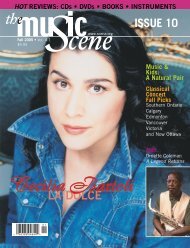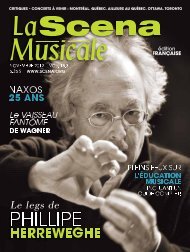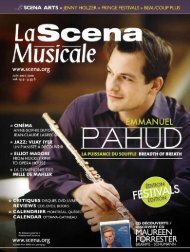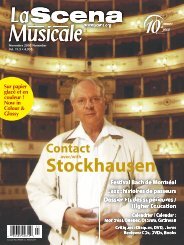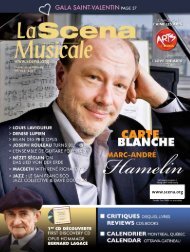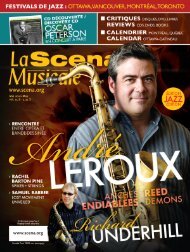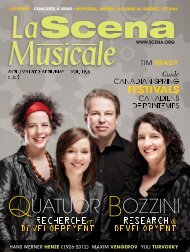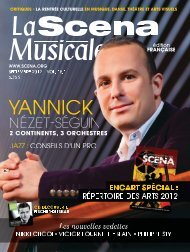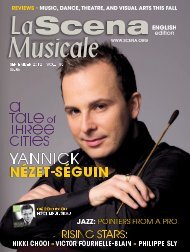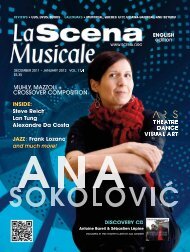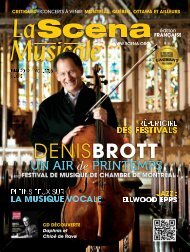Create successful ePaper yourself
Turn your PDF publications into a flip-book with our unique Google optimized e-Paper software.
EDUCATION<br />
»»»<br />
MUSICAL AVATARS<br />
Crystal Chan<br />
For a few glorious minutes, you<br />
become Haydn. That’s the idea<br />
behind the Schulich School of<br />
Music Centre for Interdisciplinary<br />
Research in Music Media and<br />
Technology (CIRMMT)’s latest star project.<br />
The first-ever recording using CIRMMT’s<br />
cutting-edge ‘room-capture’ technology<br />
celebrates the 200th anniversary of Joseph<br />
Haydn’s death. Virtual Haydn, a NAXOS<br />
four-Blu-ray-disc set of the composer’s<br />
complete keyboard works performed by<br />
pianist and professor Tom Beghin, was<br />
released last month.<br />
Before this, capturing period music had<br />
obvious flaws. Most recordings take place<br />
in or approximate the sound of concert<br />
halls. But those were uncommon until late<br />
in Haydn’s day. Recording in-studio and<br />
reproducing authentic performance<br />
spaces’ acoustics only in post-production<br />
means musicians play in dry, acoustically<br />
perfect rooms with little reverberation and cater<br />
their performance to this unnatural setting.<br />
Move the recording on-location, however, and<br />
one finds 18 th century concert spaces now surrounded<br />
by modern noise and traffic. Myriad<br />
other factors get in the way: instruments such<br />
as square pianos and clavichords are rare, for<br />
example, and original instruments’ response<br />
and tone have degraded from aging.<br />
Frustrated by these flaws, Beghin and Martha<br />
de Francisco, a noted recording engineer and<br />
producer, decided to collaborate on a revolutionary<br />
recording on their first day of teaching at<br />
McGill in 2003. Smooth-playing replicas of seven<br />
historically accurate instruments were commissioned,<br />
many the first of their kind in modern<br />
times; some can play then-common elements<br />
such as “Viennese short octaves” (requiring<br />
wider chords), which cannot be played on modern<br />
keyboards.<br />
THE OLD MUSIC<br />
BECOMES MODERN<br />
TECHNOLOGY AGAIN<br />
The tables really turned when CIRMMT<br />
founding director Wieslaw Woszcyk came along:<br />
what if, he suggested, their studio was transformed<br />
into Haydn’s study, or the Esterháza<br />
Castle in Hungary, where Haydn was the resident<br />
composer, or the Holywell Music Room,<br />
where Haydn played during the English tours<br />
that gained him celebrity status?<br />
To do so, they developed technology capable of<br />
capturing the acoustic characteristics of these<br />
and six other rooms. These characteristics can<br />
then be plugged into a studio. Back in Montreal,<br />
Beghin performed pieces on specific instruments<br />
and ‘in specific rooms’ according to the carefully<br />
researched music history of Haydn’s repertoire.<br />
The music is manipulated live, so Beghin can<br />
hear the music as if he were in one of Haydn’s old<br />
haunts as he performs—no traffic or plane tickets<br />
necessary. Some sonatas are even recorded ‘in<br />
Haydn’s study’ at his clavichord, with the microphone<br />
configuration directing the sound from<br />
the player’s position. It’s the closest one can get<br />
inside a composer’s head.<br />
“The old music becomes modern technology<br />
again,” said Beghin.<br />
This crowning jewel of the historically<br />
informed performance movement comes with a<br />
making-of documentary and one-minute clips of<br />
the same music played in all possible pairings of<br />
room and keyboard for the listener to compare. ■<br />
www.thevirtualhaydn.com<br />
- TOM BEGHIN<br />
PHOTO : JACQUES ROBERT<br />
OTHER NEWS FROM MCGILL<br />
The popularity of the graduate program at<br />
McGill’s Schulich School of music has compelled<br />
the school to create a second orchestra (the<br />
McGill Sinfonietta) to provide students with<br />
more performing opportunities. Invited artists<br />
for the school’s Year of the Woodwinds include<br />
bassoonist Carlo Colombo, flutist Jeanne<br />
Baxtresser, oboist Stefan Schilli and clarinetist<br />
<strong>La</strong>rry Combs while percussionist Joe <strong>La</strong>Barbera is<br />
this year’s Jazz Visiting Artist. New on the faculty<br />
include Matthias Maute and François Ouimet<br />
in the choral department and Richard King in<br />
Sound Recording. David Lefkowich will guest<br />
direct Opera McGill’s January production of<br />
Stravinsky’s The Rake’s Progress. Don MacLean,<br />
who is in his last year as Dean, hopes to raise the<br />
$10-million needed to complete the School’s<br />
world-class sound recording studio.<br />
Wah Keung Chan<br />
Novembre 2009 November 65



